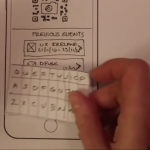Design research both inspires imagination and informs intuition through a variety of methods with related intents: to expose patterns underlying the rich reality of people’s behaviors and experiences, to explore reactions to probes and prototypes, and to shed light on the unknown through iterative hypothesis and experiment.
Jane Fulton Suri, creative director, IDEO – “Informing
Our Intuition: Design Research for Radical Innovation” – http://
bkaprt.com/jer/1/
Having chosen the audience engagement app as our project, we moved to the research stage. The purpose of this stage was to understand understand the needs of people for whom we were designing, the end users. The steps we would take were:
- Define the research problem
- Select the approach
- Plan and prepare for the research.
- Collect the data.
- Analyze the data.
- Report the results.
1. Defining the Research Problem
This purpose of this was to define our research problem statement – the statement that would describe the topic, and the goal of our research.
After discussion we concluded our research problem statement was “We will identify the user-types, and pain points, in audience engagement”
2. Selecting the approach
Our research problem statement related to users, which meant user research was required, however it also related to assessing a potential design solution, which indicated a need for some sort of evaluative research.

The phase of development we were in – strategising – pointed towards a quantitative and qualitative approach, using surveys.

3. Plan and prepare for the research
We took on a joint author role in research. Planning and preparation involved designing the survey questions, with group feedback, and subsequent edits.
Recruitment of survey participants came from friends/family and work colleagues. We felt no screening was necessary, as members of these groups all represented our target group, in that they:
- Shared the goals of our target users – proficient users of technology, and owners of mobile devices, people who regularly used the Internet, and they would frequently be members of audience, either in person or remotely
- Shared the characteristics of our target users
- Were familiar with the same relevant technologies as our target users, and were intermediate to expert technology users
Questions posed would be both qualitative and quantitative. The quantitative sections would address participant demographics, and the relevance/appeal of our proposed app. The optional qualitative section was used to gain insight into participants’ prior experiences and any suggestions they had, based on that experience.
The finished survey can be found here: Survey-Questions and was shared with participants via Google Forms.
4. Analysing the data
There were 73 responses to our survey in total. Analysis revealed the following noteworthy trends:
Likely to engage as audience member without an app
1 = less likely, 5 = more likely

Reasons for engaging, or not, included:
For engaging:
- Self promotion
- Want to know more, or to understand
“Main reason would be to subtly promote the company I work for”
Against engaging:
- Nervous or shy
- Concerns about timing, or interrupting
“I don’t want to ask a stupid question when on the spot.”
Motivations for using the app, versus concerns about using the app:
Motivations, needs and triggers:
- Anonymity, less pressure and more time to think
- No need to wait
- Prioritised questions
“I’d wait to see the room, if others were asking questions, what kind of questions they ask etc before committing myself to speaking.”
and
“I have participated via a mobile application at UX camp NL and it was extremely more efficient. I could see the types of questions others were asking, I could formulate my question as not to do it on the spot when called upon, much more user friendly”
Concerns and frustrations:
- Digital tools not friendly or personable
- Context and tone
“I don’t like the idea of using a digital tool to ask a question, especially if I’m in the audience.”
“At large conferences it’s not always possible to ask questions face-to-face. At smaller events where it is possible, it can be a lot of pressure to articulate and present in front of a large crowd particularly when the question/topic under discussion contains sensitive perspectives eg. politics / equality / personal etc.”
and
“Dislike of overuse of smartphones in social environments.”
Usage Goals:
When asked “Which of the following features would you find useful in an application for audience engagement at an event?”
- 83% chose “Ability to view presentation materials”
- 76% chose “Live questions & answers”
- 50% chose “Voting for questions”
- 40% chose “Live polling”
“Instead of it being a free for all, only the “best/most relevant” questions should be allowed to be asked. This is hard to do on the fly”“Having a view of questions people wanted to ask, a key objective would be to give a channel for a wider group of people who might otherwise be deterred from asking a question in a large forum of people”
“[I would like to] have the possibility to view slides or live coding on my phone/laptop”
Technology used:
- Smartphones – 82%
- Wearables – 4%
- Tablet computers – 8.2%
- Laptop computers – 43%
And finally, how likely would you be to engage as audience member with an app:


5. Reporting the results.
Competitor Analysis
We engaged in a round competitor analysis in order to evaluate existing solutions, noting details, including the date the competitor organisation was founded, noteworthy functionality, competitive advantage, and any other details we thought might be useful.
The sector was surprisingly busy, with both direct and indirect competition. Competitors offered both native and web apps, with the majority of them offering a white-labelled solution that they would sell directly to event organisers, these solutions often offered a back-end admin section, allowing organisers to update event-related content dynamically.
Our comptetitors also offered functionality beyond the scope of our suggested app, including event mapping, news, direct messaging of organisers and speakers, gamification, and live broadcasting.
You can view our competitor analysis document (PDF) here.
References
When to Use Which User-Experience Research Methods. (2017). Nngroup.com. Retrieved 11 November 2016, from https://www.nngroup.com/articles/which-ux-research-methods/
Conducting a Solid UX Competitive Analysis | DANFORTH. Danforth.co. Retrieved 11 November 2016, from http://danforth.co/pages/2014/03/01/conducting-a-solid-ux-competitive-analysis/
Conducting a Solid UX Competitive Analysis | DANFORTH. Danforth.co. Retrieved 11 November 2016, from http://danforth.co/pages/2014/03/01/conducting-a-solid-ux-competitive-analysis/
How to Conduct Competitive Research. (2017). Inc.com. Retrieved 11 November 2016, from http://www.inc.com/guides/2010/05/conducting-competitive-research.html

